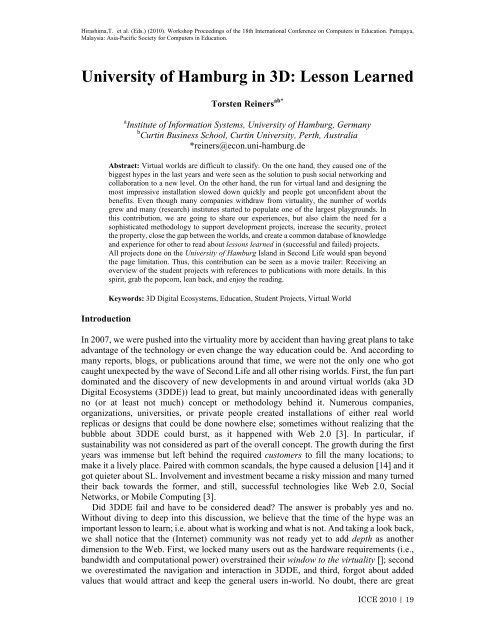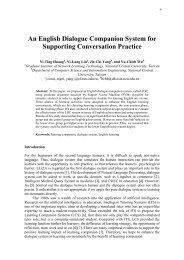ICCE2010 Workshop Proceedings - APSCE Asia-Pacific Society for ...
ICCE2010 Workshop Proceedings - APSCE Asia-Pacific Society for ...
ICCE2010 Workshop Proceedings - APSCE Asia-Pacific Society for ...
Create successful ePaper yourself
Turn your PDF publications into a flip-book with our unique Google optimized e-Paper software.
Hirashima,T. et al. (Eds.) (2010). <strong>Workshop</strong> <strong>Proceedings</strong> of the 18th International Conference on Computers in Education. Putrajaya,<br />
Malaysia: <strong>Asia</strong>-<strong>Pacific</strong> <strong>Society</strong> <strong>for</strong> Computers in Education.<br />
University of Hamburg in 3D: Lesson Learned<br />
Introduction<br />
Torsten Reiners ab*<br />
a Institute of In<strong>for</strong>mation Systems, University of Hamburg, Germany<br />
b Curtin Business School, Curtin University, Perth, Australia<br />
*reiners@econ.uni-hamburg.de<br />
Abstract: Virtual worlds are difficult to classify. On the one hand, they caused one of the<br />
biggest hypes in the last years and were seen as the solution to push social networking and<br />
collaboration to a new level. On the other hand, the run <strong>for</strong> virtual land and designing the<br />
most impressive installation slowed down quickly and people got unconfident about the<br />
benefits. Even though many companies withdraw from virtuality, the number of worlds<br />
grew and many (research) institutes started to populate one of the largest playgrounds. In<br />
this contribution, we are going to share our experiences, but also claim the need <strong>for</strong> a<br />
sophisticated methodology to support development projects, increase the security, protect<br />
the property, close the gap between the worlds, and create a common database of knowledge<br />
and experience <strong>for</strong> other to read about lessons learned in (successful and failed) projects.<br />
All projects done on the University of Hamburg Island in Second Life would span beyond<br />
the page limitation. Thus, this contribution can be seen as a movie trailer: Receiving an<br />
overview of the student projects with references to publications with more details. In this<br />
spirit, grab the popcorn, lean back, and enjoy the reading.<br />
Keywords: 3D Digital Ecosystems, Education, Student Projects, Virtual World<br />
In 2007, we were pushed into the virtuality more by accident than having great plans to take<br />
advantage of the technology or even change the way education could be. And according to<br />
many reports, blogs, or publications around that time, we were not the only one who got<br />
caught unexpected by the wave of Second Life and all other rising worlds. First, the fun part<br />
dominated and the discovery of new developments in and around virtual worlds (aka 3D<br />
Digital Ecosystems (3DDE)) lead to great, but mainly uncoordinated ideas with generally<br />
no (or at least not much) concept or methodology behind it. Numerous companies,<br />
organizations, universities, or private people created installations of either real world<br />
replicas or designs that could be done nowhere else; sometimes without realizing that the<br />
bubble about 3DDE could burst, as it happened with Web 2.0 [3]. In particular, if<br />
sustainability was not considered as part of the overall concept. The growth during the first<br />
years was immense but left behind the required customers to fill the many locations; to<br />
make it a lively place. Paired with common scandals, the hype caused a delusion [14] and it<br />
got quieter about SL. Involvement and investment became a risky mission and many turned<br />
their back towards the <strong>for</strong>mer, and still, successful technologies like Web 2.0, Social<br />
Networks, or Mobile Computing [3].<br />
Did 3DDE fail and have to be considered dead? The answer is probably yes and no.<br />
Without diving to deep into this discussion, we believe that the time of the hype was an<br />
important lesson to learn; i.e. about what is working and what is not. And taking a look back,<br />
we shall notice that the (Internet) community was not ready yet to add depth as another<br />
dimension to the Web. First, we locked many users out as the hardware requirements (i.e.,<br />
bandwidth and computational power) overstrained their window to the virtuality []; second<br />
we overestimated the navigation and interaction in 3DDE, and third, <strong>for</strong>got about added<br />
values that would attract and keep the general users in-world. No doubt, there are great<br />
ICCE 2010 | 19



